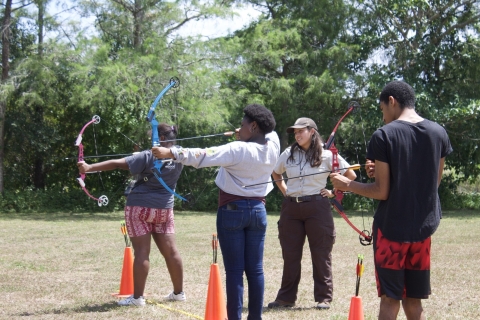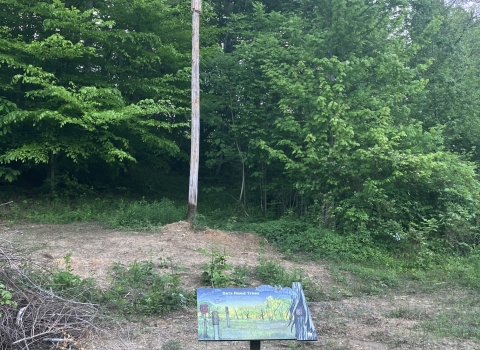In the Florida Everglades, water moves slowly through the sawgrass, and the imperceptible slope of the land makes it seem like the Everglades go on forever. If you were to stand enveloped by this sea of razor-sharp sawgrass, with no high ground to see a pathway forward, it would be easy to imagine feeling confined in unending Everglades.
Some of the northern Everglades have been drained away, shedding its sawgrass for sugarcane. The sugarcane fields’ agricultural burnings create ashfalls, which scatter down on the nearby communities already struggling with isolation and the environmental risks that come from living in a place where the difference between water and land is mere inches.
One such place is Belle Glade, the largest town in the Glades community and home to the Crossroads Academy for teens. Despite this landscape, the students have a sense of purpose, direction, and an aim for careers in the future, in part inspired by their experiences at the first ever Conservation Ranger Camp, offered in partnership with Arthur R. Marshall Loxahatchee National Wildlife Refuge, the National Wildlife Refuge Association (NWRA), and Standfirm Outreach.
Arthur R. Marshall Loxahatchee National Wildlife Refuge, which protects the northern end of the Everglades, first began the work on this over a year ago, when a partnership between the refuge, NWRA, and Standfirm Outreach came together with an idea to support the students of the Glades and help them blaze a pathway forward. The idea ultimately became the Conservation Ranger Camp but started by asking students the simple question, “What are you interested in?”
This community already has a strong connection with the outdoors – they are defined by it. The students had a deep experience with nature, especially through fishing, and their days and days deep in the Everglades sawgrass. The Conservation Ranger Camp was designed with the interests of the students in mind to cover a vast array of careers and activities in hopes of there being something for everyone, including an opportunity to work with a videographer documenting the experience.
The largest and first barrier was distance: how to get the students beyond the boundaries of their community and see the refuge and the possibilities it could hold. NWRA secured a grant to charter a bus to take them the long road around the marsh and bring them to the refuge.
This five-day camp was jam-packed with activities and experts, inspiring the students to see how their passions could lead to careers. Students met with Service wildlife inspectors who came up from Miami, staff from the Florida Fish and Wildlife Conservation Commission, refuge staff, and others. They learned about the science of habitat management from our biologists sampling for invasive tree frogs, processing a wildlife crime scene, and the importance of fire and prescribed burns in the Everglades, even getting to try on a wildlands firefighter’s safety gear used on the job. They also practiced water quality testing with a National Park Service hydrologist. To broaden experiences even further, refuge staff took the students for a day to explore and learn about Florida’s coastal ecosystems at Nathaniel P. Reed Hobe Sound National Wildlife Refuge.
At the end of the week, the students left with a certificate marking their accomplishments in the camp, a swag bag including binoculars, field guides, and fishing gear, and most notably a $500 scholarship to bring to their future. This life-changing experience could have been accomplished only by the commitment of refuge staff, grants and resources secured by Liz Figueroa at NWRA, and the passion and dedication of the people at Standfirm Outreach organization, including founder and community leader Gertavian Blake.
Supervisory park ranger Jennifer Brown describes this partnership and process as “groundbreaking.” She adds that this type of program requires “someone with the will to make that partnership.”
Rae Milmore, the urban and community engagement specialist describes it as “so rewarding to see.” Milmore has been working toward programs like this since she was a student, beginning with the Service as a Directorate Fellow intern, leading a barrier analysis first identifying the Glades and Crossroads Academy as a priority community for refuge engagement.
By the end of the week-long Conservation Ranger Camp, students were engaged and inspired, asking questions about careers, and talking of college and internships. One student even told refuge staff, "I'm going to be your co-worker soon." This fall, the Conservation Ranger Camp students will come together again for a special screening of the video documentary about the camp, which they helped to make such a remarkable experience. The screening will welcome the students, their friends and families, and the Glades community at large to watch the students discover their pathway forward to future careers, unconfined by the sawgrass.
![student holds a fishing pole facing a lily-filled pond; back of T-shirt says “Conservation Ranger Camp [year obscured] Arthur R. Marshall Loxahatchee National Wildlife Refuge”](/sites/default/files/styles/banner_image_xs/public/images/2024-09/conservation-ranger-camp-arthur-r-marshall-loxahatchee-national-wildlife-refuge-eden-taylor-national-wildlife-refuge-association-1.jpg?h=3ec75680&itok=AEiHn9hT)






